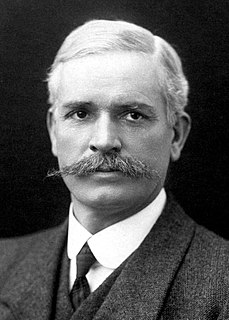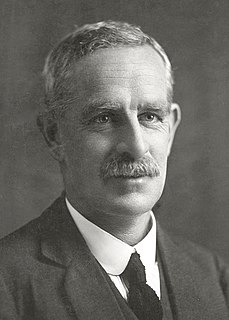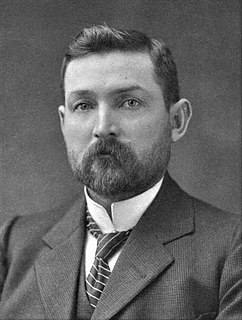
The Australian Labor Party (ALP), also simply known as Labor, is the major centre-left political party in Australia, one of two major parties in Australian politics, along with the centre-right Liberal Party of Australia. It has been in Opposition in the federal parliament since the 2013 election. The ALP is a federal party, with political branches in each state and territory. They are currently in government in Victoria, Queensland, Western Australia, South Australia, the Australian Capital Territory, and the Northern Territory. The Labor Party is the oldest political party in Australia.

The Nationalist Party, also known as the National Party was an Australian political party. It was formed on 17 February 1917 from a merger between the Commonwealth Liberal Party and the National Labor Party, the latter formed by Prime Minister Billy Hughes and his supporters after the 1916 Labor Party split over World War I conscription. The Nationalist Party was in government until electoral defeat in 1929. From that time it was the main opposition to the Labor Party until it merged with pro-Joseph Lyons Labor defectors to form the United Australia Party (UAP) in 1931. The party is a direct ancestor of the Liberal Party of Australia, the main centre-right party in Australia.

Andrew Fisher was an Australian politician who served three terms as prime minister of Australia – from 1908 to 1909, from 1910 to 1913, and from 1914 to 1915. He was the leader of the Australian Labor Party (ALP) from 1907 to 1915.

John Christian Watson was an Australian politician who served as the third prime minister of Australia, in office from 27 April to 18 August 1904. He served as the inaugural federal leader of the Australian Labor Party (ALP) from 1901 to 1907 and was the first member of the party to serve as prime minister.
The Protectionist Party or Liberal Protectionist Party was an Australian political party, formally organised from 1887 until 1909, with policies centred on protectionism. The party advocated protective tariffs, arguing it would allow Australian industry to grow and provide employment. It had its greatest strength in Victoria and in the rural areas of New South Wales. Its most prominent leaders were Sir Edmund Barton and Alfred Deakin, who were the first and second prime ministers of Australia.

Francis Gwynne Tudor was an Australian politician who served as the leader of the Australian Labor Party from 1916 until his death. He had previously been a government minister under Andrew Fisher and Billy Hughes.
The Liberal Party was a parliamentary party in Australian federal politics between 1909 and 1917. The party was founded under Alfred Deakin's leadership as a merger of the Protectionist Party and Anti-Socialist Party, an event known as the Fusion.

King O'Malley was an American-born Australian politician who served in the House of Representatives from 1901 to 1917, and served two terms as Minister for Home Affairs. He is remembered for his role in the development of the national capital Canberra as well as his advocacy for the creation of a national bank.

Gregor McGregor was an Australian politician who served as a Senator for South Australia from 1901 until his death in 1914, representing the Labor Party. He was the party's inaugural Senate leader, and served three terms as Leader of the Government in the Senate.

Sir George Foster Pearce KCVO was an Australian politician who served as a Senator for Western Australia from 1901 to 1938. He began his career in the Labor Party but later joined the National Labor Party, the Nationalist Party, and the United Australia Party; he served as a cabinet minister under prime ministers from all four parties.

Egerton Lee Batchelor was an Australian politician and trade unionist. He was a pioneer of the Australian Labor Party (ALP) in South Australia, which at the time was known as the United Labor Party (ULP). He was a member of the South Australian House of Assembly (1893–1901), leading the ULP from 1898 until his resignation in 1899 to accept a ministerial post in a non-Labor government, with the party's approval. Batchelor entered federal politics in 1901 and held cabinet posts in the first three ALP governments. He was Minister for Home Affairs (1904) under Chris Watson, and then served two terms as Minister for External Affairs under Andrew Fisher. He suffered a fatal heart attack at the age of 46 while climbing Mount Donna Buang.

Lang Labor was a faction of the Australian Labor Party (ALP) consisting of the supporters of Jack Lang, who served two terms as Premier of New South Wales and was the party's state leader from 1923 to 1939.

Charles Edward Frazer was an Australian politician. He served in the House of Representatives from 1903 until his death from pneumonia in 1913, aged 33. He was Postmaster-General in the second Fisher Ministry.
The Australian Labor Party , also known as NSW Labor and Country Labor in regional areas, is the New South Wales branch of the Australian Labor Party. The parliamentary leader is elected from and by the members of the party caucus, comprising all party members in the Legislative Assembly and Legislative Council. The party factions have a strong influence on the election of the leader. The leader's position is dependent on the continuing support of the caucus and the leader may be deposed by failing to win a vote of confidence of parliamentary members. By convention, the premier sits in the Legislative Assembly, and is the leader of the party controlling a majority in that house. The party leader also typically is a member of the Assembly, though this is not a strict party constitutional requirement. Barrie Unsworth, for example, was elected party leader while a member of the Legislative Council. He then transferred to the Assembly by winning a seat at a by-election.

Matthew Charlton was an Australian politician who served as leader of the Australian Labor Party (ALP) and Leader of the Opposition from 1922 to 1928. He led the party to defeat at the 1922 and 1925 federal elections.

The history of the Australian Labor Party has its origins in the Labour parties founded in the 1890s in the Australian colonies prior to federation. Labor tradition ascribes the founding of Queensland Labour to a meeting of striking pastoral workers under a ghost gum tree in Barcaldine, Queensland in 1891. The Balmain, New South Wales branch of the party claims to be the oldest in Australia. Labour as a parliamentary party dates from 1891 in New South Wales and South Australia, 1893 in Queensland, and later in the other colonies.

The Watson Government was the third federal executive government of the Commonwealth of Australia. It was led by Prime Minister Chris Watson of the Australian Labor Party from 27 April 1904 to 18 August 1904. The Watson Government was the first Labor Party national government in both Australia and in the world. Watson was aged just 37 when he became Prime Minister of Australia, and remains the youngest person to have held the post.

The Australian Labor Party held a leadership election on 12 July 1945, following the death of Prime Minister John Curtin. Treasurer Ben Chifley won an absolute majority on the first ballot, defeating three other candidates: deputy leader and interim prime minister Frank Forde, navy minister Norman Makin, and attorney-general H. V. Evatt.

The Australian Labor Party held a leadership election on 1 October 1935, following the resignation of James Scullin. John Curtin was elected as his replacement, defeating Frank Forde and Norman Makin, and consequently became Leader of the Opposition.

The Australian Labor Party held a leadership election on 30 October 1907, following the resignation of Chris Watson. The party elected Andrew Fisher as its new leader, ahead of three other candidates.



















